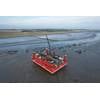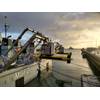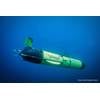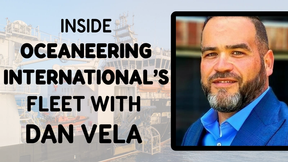The UK subsea industry has grown by 40% over the past three years and now holds almost half of the global market. The EU referendum has plunged the industry into uncertainty and the UK must now wait to see how June’s historic vote shapes the future of one of its fastest growing sectors. The interconnected nature of subsea, renewables and offshore activities makes predicting impacts even more difficult as the market attempts to understand the challenges, and possible opportunities, ahead.
At the forefront of innovative technologies, the UK’s subsea sector drives advancement in offshore developments through the provision of equipment, experience and skills to the global markets. According to NOF Energy’s Subsea Northeast group, the UK subsea sector supports more than 66,000 jobs in more than 750 companies, supplying goods and services valued in excess of $11.2 billion.
George Rafferty, Chief Executive of NOF Energy, comments, “The UK subsea sector is enormously important. Firstly, the value of the sector to the UK economy is around $1.9 abd $2.5 billion annually. Lots of companies in the UK have a global footprint and we’re recognized as a leading sector, not only in oil and gas but increasingly in offshore wind as well. We lead the way in subsea technology and these technologies will continue to be used and developed for the entire subsea sector globally. The UK is also the largest market in offshore wind and our subsea sector will play a very large role in its development, not only in the UK but also in Europe and elsewhere.”
The UK’s commitment to supporting low carbon energy, North Sea activities and promoting UK content assumes, post-Brexit, the government will continue to push for growth in its subsea, offshore and marine energy sectors. As these activities are linked, the growth of the subsea sector relies on the continued support of offshore renewables, oil and gas and large EU directives such as the new high voltage subsea connecters linking the UK and Europe.
It is likely that, for the foreseeable future, the European market will remain uncertain as we wait to see if industrial links between the UK and Europe remain connected. For now, mixed responses throughout the sectors create further uncertainties as companies on all levels attempt to carry on with business as usual.
Brexit and UK Content
Over recent years the UK Government has adopted a strong agenda to promoting UK supply chain content for offshore wind farm developments. The decision to leave the EU may unsettle important original equipment manufacturers (OEMs) and other major supply chain firms who were considering investing in the UK, and delay or deter this investment. If so, this could negatively impact the ability to maximize UK content and the long-term development of the supply chain.
Proximity to a good stream of offshore wind developments is an important factor for OEMs considering investing in the UK. Further factors include perceived long-term stability of national renewable energy policy and support, and general investment factors such as a favorable business environment, access to skilled people and costs of land and premises. However, it is the overall uncertainty about how Brexit might play out and how that affects the pipeline of new offshore wind developments that is likely to be the main concern to the industry.
Regeneris Consulting is a specialist economic development and regeneration company that has worked with many clients in the offshore and marine energy sectors. Associate Director, Stuart Younger, explains, “At the moment, any major growth of the UK offshore wind supply chain is most likely to be driven by investment from large OEMs or other major supply chain firms from overseas – particularly from elsewhere in Europe. If you look at how the supply chain works, lower tier suppliers often cluster in close proximity to these OEMs and major supply chain firms. So, if they settle in the UK they will often attract other companies in their supply chain who will want to be based nearby, as well as support the growth of existing lower tier UK supply chain firms. For the UK supply chain to grow substantially and UK content in the offshore wind supply chain to increase, we need to attract more investment from these large firms. And, the more uncertainty there is, the more risk that this could put these firms off invest ing in the UK.” While there are concerns as to what extent UK investment is perceived a risk, there has been a lot of progress in developing the UK’s offshore wind supply chain in recent years. After the EU referendum, one of the potential positives from a UK supply chain perspective is the relative cost of UK sourced goods and services. As the cost of importing increases due to a weaker pound, goods and services from the UK will look more attractive by comparison, which could help to increase the UK supply chain sourcing.
Pierre Boyde, Commercial Director at DeepOcean, expresses concerns. “One significant issue we have right now is that when we tender for future projects, which involve the supply and engineering of UK based goods and services, we have considerable uncertainty as to what tariffs will apply past 2018. This is critically important for big contracts because they’re two to three years ahead, minimum. It’s very different for people who are planning months ahead. I know what will happen with tariffs and duties in three months’ time, but what’s going to happen in three years’ time? If you choose to qualify the risk it could make our offer unattractive to the end customer. In order to minimize this risk, we may be forced to use EU-based subcontractors rather than UK-based subcontractors.”
Losing Connections
A critical point of interest for the subsea industry going forward are the new generation of subsea high voltage connectors between the UK and other European countries.
Boyde explains, “These are designated as European Projects of Common Interest (PCI) and not only benefit from accelerated planning and permitting procedures but are eligible to receive EU funding via the $5.7 ‘Connecting Europe Facility’. There are currently 16 subsea power cable projects across Europe that have applied for this status; eight of these projects connect to the UK with a total capacity of approximately 8 GW, or approximately 20% of the UK’s total current electricity supply. DeepOcean and many other UK subsea players play a significant role in the planning and execution of these projects. Clarity is therefore needed as to whether subsea power cable projects connecting to the UK will qualify in the future for this funding. In five to 10 years’ time, on a cold winter’s night, these interconnectors may be keeping the lights on in the UK.”
Furthermore, one of the fundamental business cases for these interconnectors was cheaper electricity prices. The wholesale price of UK electricity is currently around double that on the continent. Therefore, for each connector installed the market price of electricity in the UK goes down by 1%. This raises the question that, post-Brexit, would there be a stable regulatory and funding regime to put these projects in place if the UK leaves?
Cost for Future Developments
With a weaker pound, imports are more expensive, and following Brexit, if trade agreements become less favorable, this could further add to the cost of construction and ongoing operations and maintenance, pushing up the overall cost of producing offshore wind energy and creating a less attractive market.
Younger comments, “With regards to UK offshore wind and marine energy sectors, there are possible impacts on both the cost of construction and of annual operations and maintenance of energy infrastructure. However, the longer term impact on the offshore wind and marine energy sectors will be affected not just by the specific impact on the cost of producing energy from these sectors, but more importantly by the comparative impact versus other energy sources, which are competitors.”
“Again, it is difficult to assess what this overall effect will be,” Younger continues. “In the construction phase of offshore wind developments around 50-80% of spending is typically on imported goods and services which could be significantly affected by a rising cost of imports. However, once constructed, offshore wind represents a UK-based power source, so a rising cost of imports would have limited impact on annual power generation costs.”
On the marine energy side, the loss of EU funding is a particular concern. The EU provides valuable European Regional Development Fund monies for low carbon and renewable energy development, which parts of the UK have used to support the development of early stage wave and tidal energy generation technology, including substantial investment in Wales. This money is seeking to help these technologies reach a stage at which they can compete commercially with other energy technologies as well as embed their supply chains in the UK. By leaving the EU, this funding will be lost, and it is currently unknown whether or how this might be replaced by the UK government. Even if this funding is replaced, it may not come with the same requirement for investment in low carbon sectors, and so could get diverted to other economic priorities.
Further Political Instability
The prospect of further instability by another Scottish referendum causes additional concerns for the offshore sectors, especially subsea and oil and gas. The recent slump in oil prices due to high costs and dwindling resources, less spending by producers and the threat of further jobs cuts demands political instability to be minimized and a more attractive investment climate to be created.
Boyde stresses, “The other really big one for the UK subsea industry is that Brexit could potentially lead to a breakup of the UK. Then a big hit, which happened at the last referendum, is that people will put a North Sea oil and gas development spending on hold for a while until they know the nature of the settlement. Particularly, given oil and gas prices, a lot of investments are now even more marginal. I think having the double whammy of a low oil price and further financial uncertainty around projects, whilst the UK is haggling with the EU and Scotland haggling with the UK, there is a risk that responding could be put on the back burner.”
Whatever the case, the decision to leave the EU signals a challenging time ahead. The interconnecting nature of these offshore and subsea sectors means that impacts must be viewed together and not in isolation. The UK government also needs to make it clear to all sectors what will be their level of commitment and support going forward to help reduce uncertainty and minimize political instability in the shadow of another referendum.
The common response is that it is still too early to tell what the longer-term impacts will be. Some organizations are hoping to find new opportunities within the newfangled market. The indications are that at least for now companies will attempt, but may struggle, to continue with business as usual until the future of the industry is clearer.
“The businesses that can offer new technology and are in niche positions within the market will always survive. Those offering off-the-shelf products, however, will struggle. Many of the subsea businesses in the UK, and here in the Northeast of England, offer niche specialist technology and they’re developing, so they will always be in demand. Like I said during the Scottish independence referendum in 2014, businesses will work with whatever political structures form after any vote. Businesses will adapt and get on with it. They’re global players, and while Europe is important, there are other markets elsewhere,” Rafferty says.
Acknowledgements
George Rafferty, Chief Executive of NOF Energy.
Pierre Boyde, Commercial Director at DeepOcean.
Stuart Younger, Associate Director at Regeneris Consulting













 August 2025
August 2025



